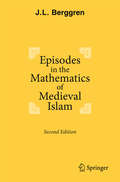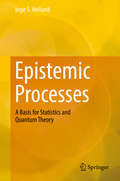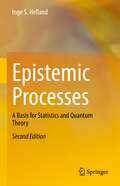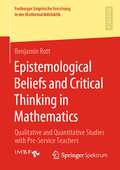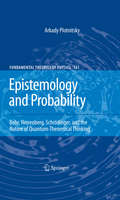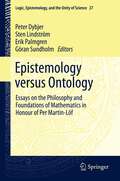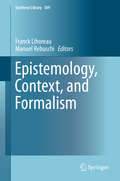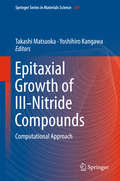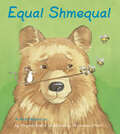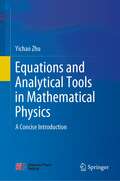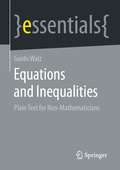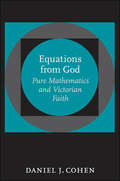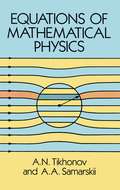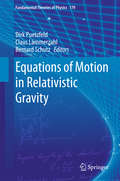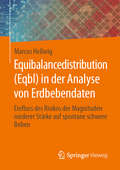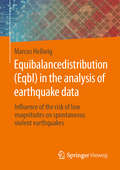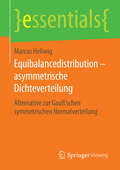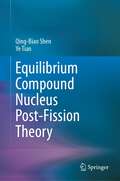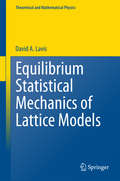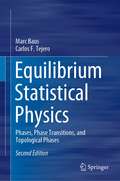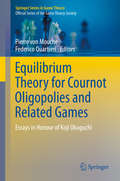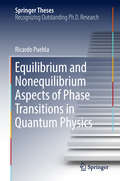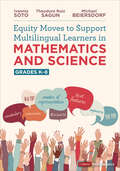- Table View
- List View
Episodes in the Mathematics of Medieval Islam
by J. L. BerggrenThis book presents an account of selected topics from key mathematical works of medieval Islam, based on the Arabic texts themselves. Many of these works had a great influence on mathematics in Western Europe. Topics covered in the first edition include arithmetic, algebra, geometry, trigonometry, and numerical approximation; this second edition adds number theory and combinatorics. Additionally, the author has included selections from the western regions of medieval Islam--both North Africa and Spain. The author puts the works into their historical context and includes numerous examples of how mathematics interacted with Islamic society.
Epistemic Processes: A Basis for Statistics and Quantum Theory
by Inge S. HellandThis book discusses a link between statistical theory and quantum theory based on the concept of epistemic processes – which can be e.g. statistical investigations or quantum mechanical measurements, and refer to processes that are used to gain knowledge about something. The book addresses a range of topics, including a derivation of the Born formula from reasonable assumptions, a derivation of the Schrödinger equation in the one-dimensional case, and a discussion of the Bell inequality from an epistemic perspective. The book describes a possible epistemic foundation of quantum theory. Lastly, it presents a general philosophical discussion of the approach, which, principally speaking, is not restricted to the micro-world. Hence the book can also be seen as a motivation for further research into quantum decision theory and quantum models for cognition. The book will benefit a broad readership, including physicists and statisticians interested in the foundation of their disciplines, philosophers of science and graduate students, and anyone with a reasonably good background in mathematics and an open mind.
Epistemic Processes: A Basis for Statistics and Quantum Theory
by Inge S. HellandThis book discusses a link between statistical theory and quantum theory based on the concept of epistemic processes. The latter are processes, such as statistical investigations or quantum mechanical measurements, that can be used to obtain knowledge about something. Various topics in quantum theory are addressed, including the construction of a Hilbert space from reasonable assumptions and an interpretation of quantum states. Separate derivations of the Born formula and the one-dimensional Schrödinger equation are given. In concrete terms, a Hilbert space can be constructed under some technical assumptions associated with situations where there are two conceptual variables that can be seen as maximally accessible. Then to every accessible conceptual variable there corresponds an operator on this Hilbert space, and if the variables take a finite number of values, the eigenspaces/eigenvectors of these operators correspond to specific questions in nature together with sharp answers to these questions. This paves a new way to the foundations of quantum theory. The resulting interpretation of quantum mechanics is related to Hervé Zwirn's recent Convivial Solipsism, but it also has some relations to Quantum Bayesianism and to Rovelli's relational quantum mechanics. Niels Bohr's concept of complementarity plays an important role. Philosophical implications of this approach to quantum theory are discussed, including consequences for macroscopic settings.The book will benefit a broad readership, including physicists and statisticians interested in the foundations of their disciplines, philosophers of science and graduate students, and anyone with a reasonably good background in mathematics and an open mind.
Epistemological Beliefs and Critical Thinking in Mathematics: Qualitative and Quantitative Studies with Pre-Service Teachers (Freiburger Empirische Forschung in der Mathematikdidaktik)
by Benjamin RottEpistemological beliefs—i.e. beliefs on the nature of knowledge, its limits, sources, and justification—play an important role both in everyday life and in learning processes. This book comprises several studies dealing with such beliefs in the domain of mathematics; amongst others a qualitative interview study, and quantitative studies for which a new questionnaire has been developed. In this new instrument, belief position (e.g. “mathematical knowledge is certain” vs. “uncertain”) and belief argumentation (the way those positions are justified) are differentiated. Additionally, a test for mathematical critical thinking has been designed.The results show significant correlations between sophisticated belief argumentations and high scores in the critical thinking test, but no correlations regarding belief positions.
Epistemology and Natural Philosophy in the 18th Century: The Roots of Modern Physics (History of Mechanism and Machine Science #39)
by Danilo CapecchiThis book documents the process of transformation from natural philosophy, which was considered the most important of the sciences until the early modern era, into modern disciplines such as mathematics, physics, natural history, chemistry, medicine and engineering. It focuses on the 18th century, which has often been considered uninteresting for the history of science, representing the transition from the age of genius and the birth of modern science (the 17th century) to the age of prodigious development in the 19th century. Yet the 18th century, the century of Enlightenment, as will be demonstrated here, was in fact characterized by substantial ferment and novelty. To make the text more accessible, little emphasis has been placed on the precise genesis of the various concepts and methods developed in scientific enterprises, except when doing so was necessary to make them clear. For the sake of simplicity, in several situations reference is made to the authors who are famous today, such as Newton, the Bernoullis, Euler, d’Alembert, Lagrange, Lambert, Volta et al. – not necessarily because they were the most creative and original minds, but mainly because their writings represent a synthesis of contemporary and past studies. The above names should, therefore, be considered more labels of a period than references to real historical characters.
Epistemology and Probability
by Arkady PlotnitskyThe book offers an exploration of the relationships between epistemology and probability in the work of Niels Bohr, Werner Heisenberg, and Erwin Schrödinger; in quantum mechanics; and in modern physics as a whole. It also considers the implications of these relationships and of quantum theory itself for our understanding of the nature of thinking and knowledge in general. These implications are radical and controversial. While they have been seen as scientifically productive and intellectually liberating to some, Bohr and Heisenberg among them, they have been troublesome to many others, beginning with Schrödinger and, most famously, Einstein, who refused to believe that God would resort to playing dice, as quantum theory appeared to demand. The situation led to an intense debate, in particular the great confrontation between Einstein and Bohr, which began around the time of the discovery of quantum mechanics by Heisenberg and Schrödinger in 1920s and has overshadowed the history of the debate concerning quantum mechanics ever since. The controversy itself surrounding quantum theory and the intensity of the debate concerning it have remained undiminished. No end appears to be in sight. At the same time, in spite of the enormous and ever proliferating amount of commentaries in all genres (technical, philosophical, and popular), some of the deeper philosophical aspects of quantum mechanics and of the philosophical thought of the figures considered in this study often remain explored. The main aim of this book is to contribute to a better understanding of the nature of quantum-theoretical thinking and of the reasons for this extraordinary impact and controversy. Philosophically, the book pursues this task by bringing together in a new way the relationships between epistemology and probability in quantum theory and beyond. Historically, it does so by engaging comprehensively and in a mutually illuminating way with the work of all three key figures responsible for the birth of quantum mechanics - Heisenberg, Schrödinger, and, as concerns quantum epistemology, Bohr - which has not be previously done in literature on quantum mechanics. Among other key contributions of the book is an analysis of the role of mathematics in quantum theory and in the thinking of Bohr, Heisenberg, and Schrödinger; a new treatment of the famous experiment of Einstein, Podolsky, and Rosen (EPR) and of the Bohr-Einstein exchange concerning it; and an exploration of the implications of the epistemological problematics considered by the book for new developments of quantum mechanics itself, such as quantum information theory, on the one hand, and, on the other, for higher-level physical theories, from quantum field theory to string/brane theories and new cosmological theories.
Epistemology versus Ontology
by B. G. Sundholm Erik Palmgren P. Dybjer Sten LindströmThis book brings together philosophers, mathematicians and logicians to penetrate important problems in the philosophy and foundations of mathematics. In philosophy, one has been concerned with the opposition between constructivism and classical mathematics and the different ontological and epistemological views that are reflected in this opposition. The dominant foundational framework for current mathematics is classical logic and set theory with the axiom of choice (ZFC). This framework is, however, laden with philosophical difficulties. One important alternative foundational programme that is actively pursued today is predicativistic constructivism based on Martin-Löf type theory. Associated philosophical foundations are meaning theories in the tradition of Wittgenstein, Dummett, Prawitz and Martin-Löf. What is the relation between proof-theoretical semantics in the tradition of Gentzen, Prawitz, and Martin-Löf and Wittgensteinian or other accounts of meaning-as-use? What can proof-theoretical analyses tell us about the scope and limits of constructive and predicative mathematics?
Epistemology, Context, and Formalism (Synthese Library #369)
by Franck Lihoreau Manuel RebuschiThe main purpose of the present volume is to advance our understanding of the notions of knowledge and context, the connections between them and the ways in which they can be modeled, in particular formalized – a question of prime importance and utmost relevance to such diverse disciplines as philosophy, linguistics, computer science and artificial intelligence and cognitive science.Bringing together essays written by world-leading experts and emerging researchers in epistemology, logic, philosophy of language, linguistics and theoretical computer science, the book examines the formal modeling of knowledge and the knowledge-context link at one or more of three intersections - context and epistemology, epistemology and formalism, formalism and context – and presents a novel range of approaches to the current discussions that the connections between knowledge, language, action, reasoning and context continually enlivens. It develops powerful ideas that will push the relevant fields forward and give a sense of the new directions in which mainstream and formal research on knowledge and context is heading.
Epitaxial Growth of III-Nitride Compounds: Computational Approach (Springer Series in Materials Science #269)
by Takashi Matsuoka Yoshihiro KangawaThis book presents extensive information on the mechanisms of epitaxial growth in III-nitride compounds, drawing on a state-of-the-art computational approach that combines ab initio calculations, empirical interatomic potentials, and Monte Carlo simulations to do so. It discusses important theoretical aspects of surface structures and elemental growth processes during the epitaxial growth of III-nitride compounds. In addition, it discusses advanced fundamental structural and electronic properties, surface structures, fundamental growth processes and novel behavior of thin films in III-nitride semiconductors. As such, it will appeal to all researchers, engineers and graduate students seeking detailed information on crystal growth and its application to III-nitride compounds.
Equal Shmequal
by Virginia KrollWhat does it mean to be equal? Mouse and her friends want to play tug-of-war but they can't figure out how to make teams that are equal. Nothing works until Mouse starts thinking mathematically. Wonderful illustrations capture Mouse and her animal friends from whiskers to tails.
Equations and Analytical Tools in Mathematical Physics: A Concise Introduction
by Yichao ZhuThis book highlights a concise and readable introduction to typical treatments of partial differential equations in mathematical physics. Mathematical physics is regarded by many as a profound discipline. In conventional textbooks of mathematical physics, the known and the new pieces of knowledge often intertwine with each other. The book aims to ease readers' struggle by facilitating a smooth transition to new knowledge. To achieve so, the author designs knowledge maps before each chapter and provides comparative summaries in each chapter whenever appropriate. Through these unique ways, readers can clarify the underlying structures among different equations and extend one's vision to the big picture. The book also emphasizes applications of the knowledge by providing practical examples. The book is intended for all those interested in mathematical physics, enabling them to develop a solid command in using partial differential equations to solve physics and engineering problems in a not-so-painful learning experience.
Equations and Inequalities: Plain Text for Non-Mathematicians (essentials)
by Guido WalzThe book teaches the basics of solving equations and inequalities in easily understandable language. One of the main topics is the solving of quadratic equations, regardless of whether they already exist in normal form or have to be brought into it first. The author treats the p-q formula and the midnight formula as tools for this purpose. In addition, the book deals with linear equations and, in general, with the question of which manipulations one may make on an equation without changing its solutions. Furthermore, the most important inequalities are treated and strategies for their solution are shown.This Springer essential is a translation of the original German 1st edition essentials, Gleichungen und Ungleichungen by Guido Walz, published by Springer Fachmedien Wiesbaden GmbH, part of Springer Nature in 2018. The translation was done with the help of artificial intelligence (machine translation by the service DeepL.com). A subsequent human revision was done primarily in terms of content, so that the book will read stylistically differently from a conventional translation. Springer Nature works continuously to further the development of tools for the production of books and on the related technologies to support the authors.
Equations from God: Pure Mathematics and Victorian Faith (Johns Hopkins Studies in the History of Mathematics)
by Daniel J. CohenThroughout history, application rather than abstraction has been the prominent driving force in mathematics. From the compass and sextant to partial differential equations, mathematical advances were spurred by the desire for better navigation tools, weaponry, and construction methods. But the religious upheaval in Victorian England and the fledgling United States opened the way for the rediscovery of pure mathematics, a tradition rooted in Ancient Greece.In Equations from God, Daniel J. Cohen captures the origins of the rebirth of abstract mathematics in the intellectual quest to rise above common existence and touch the mind of the deity. Using an array of published and private sources, Cohen shows how philosophers and mathematicians seized upon the beautiful simplicity inherent in mathematical laws to reconnect with the divine and traces the route by which the divinely inspired mathematics of the Victorian era begot later secular philosophies.
Equations from God: Pure Mathematics and Victorian Faith (Johns Hopkins Studies in the History of Technology)
by Daniel J. CohenThis illuminating history explores the complex relationship between mathematics, religious belief, and Victorian culture.Throughout history, application rather than abstraction has been the prominent driving force in mathematics. From the compass and sextant to partial differential equations, mathematical advances were spurred by the desire for better navigation tools, weaponry, and construction methods. But the religious upheaval in Victorian England and the fledgling United States opened the way for the rediscovery of pure mathematics, a tradition rooted in Ancient Greece.In Equations from God, Daniel J. Cohen captures the origins of the rebirth of abstract mathematics in the intellectual quest to rise above common existence and touch the mind of the deity. Using an array of published and private sources, Cohen shows how philosophers and mathematicians seized upon the beautiful simplicity inherent in mathematical laws to reconnect with the divine and traces the route by which the divinely inspired mathematics of the Victorian era begot later secular philosophies.
Equations of Mathematical Physics
by A. A. Samarskii A. N. TikhonovMathematical physics plays an important role in the study of many physical processes -- hydrodynamics, elasticity, and electrodynamics, to name just a few. Because of the enormous range and variety of problems dealt with by mathematical physics, this thorough advanced undergraduate- or graduate-level text considers only those problems leading to partial differential equations. Contents:I. Classification of Partial Differential EquationsII. Evaluations of the Hyperbolic TypeIII. Equations of the Parabolic TypeIV. Equations of Elliptic TypeV. Wave Propagation in SpaceVI. Heat Conduction in SpaceVII. Equations of Elliptic Type (Continuation)The authors -- two well-known Russian mathematicians -- have focused on typical physical processes and the principal types of equations dealing with them. Special attention is paid throughout to mathematical formulation, rigorous solutions, and physical interpretation of the results obtained. Carefully chosen problems designed to promote technical skills are contained in each chapter, along with extremely useful appendixes that supply applications of solution methods described in the main text. At the end of the book, a helpful supplement discusses special functions, including spherical and cylindrical functions.
Equations of Motion in Relativistic Gravity (Fundamental Theories of Physics #179)
by Bernard Schutz Dirk Puetzfeld Claus LämmerzahlThe present volume aims to be a comprehensive survey on the derivation of the equations of motion, both in General Relativity as well as in alternative gravity theories. The topics covered range from the description of test bodies, to self-gravitating (heavy) bodies, to current and future observations.Emphasis is put on the coverage of various approximation methods (e.g., multipolar, post-Newtonian, self-force methods) which are extensively used in the context of the relativistic problem of motion. Applications discussed in this volume range from the motion of binary systems -- and the gravitational waves emitted by such systems -- to observations of the galactic center. In particular the impact of choices at a fundamental theoretical level on the interpretation of experiments is highlighted.This book provides a broad and up-do-date status report, which will not only be of value for the experts working in this field, but also may serve as a guideline for students with background in General Relativity who like to enter this field.
Equibalancedistribution (Eqbl) in der Analyse von Erdbebendaten: Einfluss des Risikos der Magnituden niederer Stärke auf spontane schwere Beben
by Marcus HellwigDas Buch beschreibt die Einschätzung des Risikos und der Wahrscheinlichkeit des Eintretens von Schäden gemäß Richterskala. Es erläutert die Verbindung der Wahrscheinlichkeitstheorie extremwertiger Prozesse mit Beispielen aus den Wissenschaften der Erdbebenbeobachtungen.
Equibalancedistribution (Eqbl) in the analysis of earthquake data: Influence of the risk of low magnitudes on spontaneous violent earthquakes
by Marcus HellwigThe book describes the assessment of the risk and probability of occurrence of damage according to the Richter scale. It explains the connection of the probability theory of extreme processes with examples from the sciences of earthquake observation. In contrast to many views, the present analysis takes into account the complete population of all measurement data of the magnitudes from 0 to the measured maximum
Equibalancedistribution - asymmetrische Dichteverteilung: Alternative zur Gauß‘schen symmetrischen Normalverteilung (essentials)
by Marcus HellwigMarcus Hellwig zeigt, dass die kurzlich entwickelte Schiefe Verteilung, im Weiteren Equibalancedistribution (Eqb) genannt, fur die Uberprufung des Prozessverhaltens von Funkubertragungen verwendet werden kann. Beobachtet wird, dass nahezu jegliche Streuung von Messwerten um einen Mittelwert ungleich schief verteilt ist. Diesem Umstand soll die Eqb dadurch Rechnung tragen, dass sie im symmetrischen Zustand eine vollstandige Abbildung der Normalverteilung (NV) ist und die Summe der Wahrscheinlichkeitsdichte innerhalb der betrachteten Varianz gegen 1 konvergiert, gleich wie die Schiefen (asymmetrische Streuungen) links oder rechts des Mittelwertes (Erwartungswert m) positioniert sind. "
Equilibrium Compound Nucleus Post-Fission Theory
by Ye Tian Qing-Biao ShenThis book proposes and develops the equilibrium compound nucleus post-fission theory, a powerful tool for studying the fission process and making numerical calculations of post-fission nuclear data. It begins with a detailed historical background on fission theory and covers fundamental concepts, such as the Bohr-Wheeler formula and time dependent nuclear density functional theory.The authors explain the kinematics of heavy-ion collisions and develop a heavy-ion spherical optical model. They also present the theoretical methods for calculating the yield, kinetic energy distribution, and angular distribution of fission fragments in the initial state of fission. In addition, readers are provided with the method for calculating the prompt neutron and prompt gamma-ray data as well as the proportion of the isomeric state nucleus and independent yield from the initial yield of the fission fragments. Using the nuclear decay data of the fission products, a method for calculating the cumulative yield and decay heat of the fission fragments is also given. A fission delayed neutron simplification model is proposed and the theoretical method for calculating the total contribution of three fission channels to post-fission nuclear data is provided.This book concludes with a step-by-step guide on numerical calculations for post-fission nuclear data and a Fortran program for optimizing the best theoretical model parameters. It is ideal for both junior and senior researchers in nuclear physics, as well as graduate students who are interested learning about the subject. Given the current interest in post-fission and the tremendous experimental and theoretical efforts in studying it, this book serves as a timely and comprehensive resource for the nuclear physics community.
Equilibrium Statistical Mechanics of Lattice Models
by David A. LavisMost interesting and difficult problems in equilibrium statistical mechanics concern models which exhibit phase transitions. For graduate students and more experienced researchers this book provides an invaluable reference source of approximate and exact solutions for a comprehensive range of such models. Part I contains background material on classical thermodynamics and statistical mechanics, together with a classification and survey of lattice models. The geometry of phase transitions is described and scaling theory is used to introduce critical exponents and scaling laws. An introduction is given to finite-size scaling, conformal invariance and Schramm--Loewner evolution. Part II contains accounts of classical mean-field methods. The parallels between Landau expansions and catastrophe theory are discussed and Ginzburg--Landau theory is introduced. The extension of mean-field theory to higher-orders is explored using the Kikuchi--Hijmans--De Boer hierarchy of approximations. In Part III the use of algebraic, transformation and decoration methods to obtain exact system information is considered. This is followed by an account of the use of transfer matrices for the location of incipient phase transitions in one-dimensionally infinite models and for exact solutions for two-dimensionally infinite systems. The latter is applied to a general analysis of eight-vertex models yielding as special cases the two-dimensional Ising model and the six-vertex model. The treatment of exact results ends with a discussion of dimer models. In Part IV series methods and real-space renormalization group transformations are discussed. The use of the De Neef--Enting finite-lattice method is described in detail and applied to the derivation of series for a number of model systems, in particular for the Potts model. The use of Pad\'e, differential and algebraic approximants to locate and analyze second- and first-order transitions is described. The realization of the ideas of scaling theory by the renormalization group is presented together with treatments of various approximation schemes including phenomenological renormalization. Part V of the book contains a collection of mathematical appendices intended to minimise the need to refer to other mathematical sources.
Equilibrium Statistical Physics: Phases, Phase Transitions, and Topological Phases
by Marc Baus Carlos F. TejeroThis is a textbook which gradually introduces the student to the statistical mechanical study of the different phases of matter and to the phase transitions between them. Throughout, only simple models of both ordinary and soft matter are used but these are studied in full detail. The subject is developed in a pedagogical manner, starting from the basics, going from the simple ideal systems to the interacting systems, and ending with the more modern topics. The textbook provides the student with a complete overview, intentionally at an introductory level, of the theory of phase transitions. All equations and deductions are included.
Equilibrium Theory for Cournot Oligopolies and Related Games
by Pierre Von Mouche Federico QuartieriThis state-of-the-art collection of papers on the theory of Cournotian competition focuses on two main subjects: oligopolistic Cournot competition and contests. The contributors present various applications of the Cournotian Equilibrium Theory, addressing topics such as equilibrium existence and uniqueness, equilibrium structure, dynamic processes, coalitional behavior and welfare. Special emphasis is placed on the aggregative nature of the games that are relevant to such theory. This contributed volume was written to celebrate the 80th birthday of Prof. Koji Okuguchi, a pioneer in oligopoly theory.
Equilibrium and Nonequilibrium Aspects of Phase Transitions in Quantum Physics (Springer Theses)
by Ricardo PueblaIn this book, the equilibrium and nonequilibrium properties of continuous phase transitions are studied in various systems, with a special emphasis on understanding how well-established universal traits at equilibrium may be extended into the dynamic realm, going beyond the paradigmatic Kibble–Zurek mechanism of defect formation. This book reports on the existence of a quantum phase transition in a system comprising just a single spin and a bosonic mode (the quantum Rabi model). Though critical phenomena are inherent to many-body physics, the author demonstrates that this small and ostensibly simple system allows us to explore the rich phenomenology of phase transitions, both in- and out-of-equilibrium. Moreover, the universal traits of this quantum phase transition may be realized in a single trapped-ion experiment, thus avoiding the need to scale up the number of constituents. In this system, the phase transition takes place in a suitable limit of system parameters rather than in the conventional thermodynamic limit – a novel notion that the author and his collaborators have dubbed the finite-component system phase transition. As such, the results gathered in this book will open promising new avenues in our understanding and exploration of quantum critical phenomena.
Equity Moves to Support Multilingual Learners in Mathematics and Science, Grades K-8 (Corwin Mathematics Series)
by Ivannia Soto Theodore Sagun Michael BeiersdorfA strengths and assets-based approach to multilingual learner success As the number of multilingual learners (MLLs) in US schools continues to grow, educators need to learn the moves necessary to support the success of these students in mathematics and science. Equity Moves to Support Multilingual Learners in Mathematics and Science, Grades K-8 focuses on the literacy opportunities that MLLs can achieve when language scaffolds are taught alongside rigorous math and science content. It provides a framework teachers can use to develop equity-centered, scaffolded math, science, or STEAM lessons. Readers will find Anchor phenomena that demonstrate issues with lesson design and delivery and highlight areas to include language and content scaffolds Examples for honoring the languages of students, families, and communities Culturally responsive techniques and easy-to-use tables featuring the equity moves Vignettes showcasing the equity move in the classroom setting A focus on four language demands: vocabulary, discourse, multiple modes of representation, and text features With an assets-based approach to what MLLs can do, this book helps teachers unpack the language demands of mathematics and science and encourages reflection of their own practices in scaffolding for language and culture.
